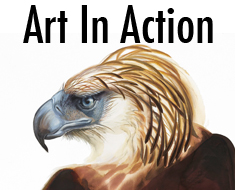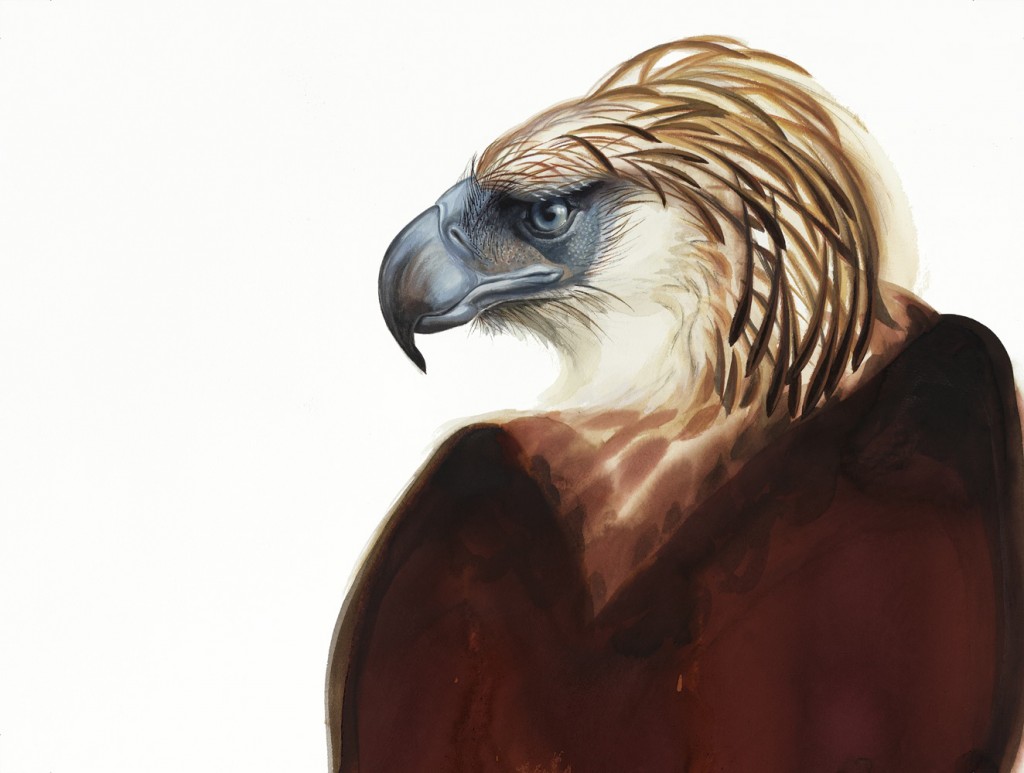Art in Action:
Jeepney Projects Worldwide’s fight to save the Great Philippine Eagle
Massive in size and striking in beauty, The Great Philippine Eagle, formerly known as the Monkey Eating Eagle, is Philippines’ national symbol. This critically endangered species is shrinking due to hunting, pollution, and habitat loss, however this icon caught the eye of Bay Area artist, David Tomb. An avid bird watcher and experienced artist, Tomb’s love of birds stems from his childhood growing up in the Oakland Hills during the 1960’s. Tomb recounts that as a toddler “I would go out on our deck and stare at a tree that had turkey vultures sunning their wings in the morning time…as the sun came up, the wings of these vultures were backlit. It was a memorable and gothic image- a gnarled oak tree with vultures sunning their wings. Perhaps that was the image that got me hooked and fascinated with birds.” Also artistically inclined as a child, Tomb was inspired by famous wildlife artists such as John James Audubon and Louis Agassiz Fuertes. Tomb attended Long Beach State University, known for its figurative painting program, and went on to work as a portrait painter for over 20 years. However, he never could forget his childhood love of birds often making appearances in the background of his figurative work.
In the early 2000’s, Tomb began to devote his artistic career entirely to the drawing and painting of birds. Studying bird skins at the California Academy of Sciences, and U.C. Berkeley (both have excellent holdings of birds), Tomb consistently creates life size schematic drawings of these amazing creatures. Taking careful notes of the colors and patterns of bird skins, Tomb frequently draws delicate and intricate renderings of these exotic bird species.
In addition to researching holdings at California Academy of Sciences and UC Berkeley, Tomb frequently embarks upon bird watching trips around the world. One specific adventure to the Philippines was in search of the Great Philippine Eagle. All it took to spark this trip was an emailed image of the Great Philippine Eagle to his junior high school friend Peter Barto, and Barto was on board for this remarkable journey. Accompanied by Ian Austin, also a birder in the Bay Area, and George Miller, a travel writer, whom Tomb met on a prior bird watching trip to Mexico, the group embarked on their search for the Great Philippine Eagle. Tomb recounts his story of seeing the eagle for the first time,
“In January we went to the island of Mindanao, which is most easily accessible place to view wild Philippine Eagles. There is a nest site on the mountain of Mount Kitanglad, in the North of Mindanao. There is a place called the lodge, built for people that worked the pineapple farm that is a real funky building with bats, and rats, and all sorts of critters. You have to go on this long drive up the mountain and unload your stuff with the help of local families, local guides, and your fellow birders onto a water buffalo and follow the buffalo, your guides, and your cooks to reach the lodge. The next morning you do a couple mile hike up the trail through a patchwork of farmland to find the nest of the Philippine eagle. We were the first group to go up so did not know if and where the Philippine eagle had nested. Waiting the entire day, through the heat and rain, I thought ‘wow I dragged all these guys here to see this bird’. It was getting nerve wracking not seeing the eagle. After three hours the second day, we saw other big raptors circling the thermals. Peter said, ‘hey guys I think I see really big raptor on the other side of the valley.’ The guide said, ‘That is the eagle.’ It was longest three seconds of my life seeing the eagle. The Philippine Eagle sighting was incredibly thrilling. Eventually we saw the bird landing on the nest where juvenile bird was eating a prey item of some kind. We had an excellent scope, which enabled a specular view like a film off of the Nature Channel. A long tailed Macaque monkey ran past the eagle and the canopy of tree was bouncing up and down. My theory was that the eagle was eating the Macaque and a troop of Macaque coming to attack. “
The majestic sighting of the Philippine eagle inspired Tomb and his two buddies from junior high school, Peter Barto and Howard Flax, along with their science advisor, Ian Austin, to help save this one of a kind eagle. Recognizing this opportunity as a merging of artistic practice and conservation efforts, Tomb, Barto, Flax, and Austin, conceived their idea of Jeepney Projects Worldwide. The mission of Jeepney Projects Worldwide is to raise awareness of critically endangered birds, such as the Great Philippine Eagle. The term “Jeepney” refers to the surplus of leftover jeeps from World War II that were re-purposed as buses or taxis in the Philippines. Often very personalized and eccentric, Jeepneys are iconic symbols of the Philippines, making Jeepneys a perfect symbol for a group using art to tell a story of another Philippine icon, the Great Philippine Eagle.
Jeepney Projects Worldwide officially launched with an exhibition at Dominican University at the San Marco Gallery, Alemany Library (September 22- October 29, 2011). The university setting was a perfect fit for the launch of a grassroots organization as it showed the student body that all it takes to start a meaningful conservation project is is three buddies from junior high school and one universal goal. Tomb remarks, “We were able to share with students what it looks like to start a grassroots conservation group and how to start a long-term art project at the very beginning and how those two converge together. It was less about having a finished product, more about a glimpse into that process. The students really responded to this, ‘Wow look at what these three buddies from high school did’. It takes inspiration, passion, and takes effort and time, but is hugely gratifying.”
As a means to reach its goal, and to add additional critically endangered birds to the groups purpose, Jeepney Projects Worldwide partnered with the Philippine Eagle Foundation to sell benefit prints made by Tomb. In addition to the sales of these benefit prints, Tomb has two upcoming exhibitions: Jeepney Projects: Vanishing Birds of the Philippines, The Bone Room, Berkeley, CA (February 2- February 29, 2012) and Jeepney Projects Worldwide, Electric Works, San Francisco, CA (June 2012). Through both of these exhibitions, Tomb hopes to tell the story of the Great Philippine Eagle while inspiring others to help save this iconic bird. Creating an immersive experience through the juxtaposition of plant life, a sound piece, and works of art, Tomb strives to replicate the experience of seeing the Great Philippine Eagle inside the white cube. Pushing the boundaries of how a gallery space can be used, Tomb’s upcoming shows at Bone Gallery and Electric Works will be a truly unique and memorable experience.
The partnering of art projects and conservation groups expands the possibility of art, and how art can play such an important role in environmental issues such as preserving quality habitats for critically endangered birds. Jeepney Projects Worldwide tells the story of the Great Philippine Eagle, inspiring others to join in the fight to save this iconic bird.
Jeepney Projects Worldwide Written by Charlottle Miller

